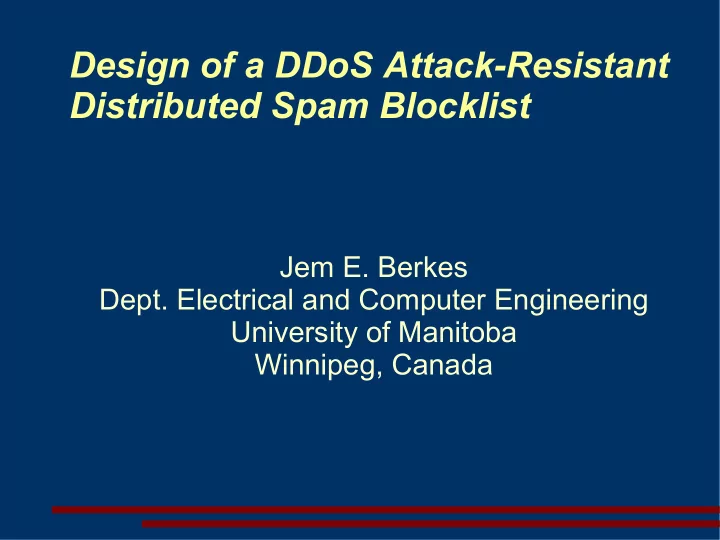

Design of a DDoS Attack-Resistant Distributed Spam Blocklist Jem E. Berkes Dept. Electrical and Computer Engineering University of Manitoba Winnipeg, Canada
Introduction ● Anti-spam blocklists are vital for the Internet ● Blocklists are targets of DDoS attacks Making operation impractical, costly ● How to make blocklists resistant to attacks?
Presentation outline ● Background Spam blocklists DNSBL technology DDoS attacks Design motivation ● Proposed solution Structure Security Implementation ● Conclusion ● Questions
Background: Spam blocklists ● Primary anti-spam measure for ISPs ● Simple, efficient, effective ● Third party database ● IPs or domain names meeting criteria, e.g. Insecure hosts/open relays/open proxies Hosts that sent spam Hosts belonging to networks that send spam ● Many databases available, nearly all are free and maintained by volunteer organizations
Background: DNSBL technology ● DNSBL: DNS Blocklist (“RBL”, “blacklist”) ● First used for Paul Vixie's MAPS/RBL, 1997
Background: DNSBL technology
Background: DNSBL technology ● DNSBLs save bandwidth! ● Front line of spam defence ● Vital for ISPs
Background: DDoS attacks ● DDoS: Distributed Denial of Service Continuous TCP/ICMP traffic from many hosts ● Blocklists are popular attack targets ● Permanently shut down due to DDoS attacks: Osirusoft, Monkeys ● Current targets of ongoing attacks: SPEWS, Spamhaus, SpamCop ● Withstanding attacks is costly
Background: Design motivation ● DNSBLs are easy to attack ● Central servers Can add more servers, but there is high cost Almost all blocklists run by volunteers ● Can blocklists be made resistant to attacks, while maintaining data integrity without requiring costly resources?
Proposed solution: Structure ● Distributed blocklist ● Peer-to-Peer system ● Pooling resources ● No central server ● Publisher in control
Proposed solution: Structure ● Who are the Nodes? Small, medium, large ISPs Anyone with resources ● Who is Publisher? Authority on blocklist data Likely, anonymous ● The point: there is no vital entity to attack
Proposed solution: Security ● All Nodes serve blocklist data ● No central server ● How can we trust blocklist contents? What enforces Publisher's control? ● Digital signatures (PGP/OpenPGP)
Proposed solution: Security ● Nodes (and users) can verify data integrity ● All Packages must be signed by Publisher ● Guarantees propagation of authentic data
Proposed solution: Implementation ● Required protocols already exist OpenPGP data signatures HTTP data transfers, or Gnutella for P2P structure ● Users could run local DNSBL i.e. No changes required to mail server software
Conclusion ● Current spam blocklists are threatened ● A distributed (Peer-to-Peer) system Eliminates central servers Allows pooling of resources ● Enforcing digital signatures Maintains data integrity and reliability Gives a Publisher sole control of data ● Distributed spam blocklist can be built using existing protocols
Questions Any questions?
Recommend
More recommend